It’s that time again! The annual WP Fusion year in review 🥳
Quick summary in case you’re landing on our site for the first time:
- WP Fusion is a plugin that integrates WordPress with CRMs and marketing automation tools. i.e. Sync WooCommerce orders into HubSpot, follow up with FooEvents registrations in ActiveCampaign, etc.
- The first version was launched February of 2015, so we’re going into our seventh year of business.
- In the spirit of open-source-ey-ness and transparency, I’ve been publishing these Year in Review posts since 2017. You can find the earlier ones at:
If you’re into this kind of thing, Igor Benić has been kind enough to put up a roundup of WordPress Year in Review posts over at https://reviewyears.com/.
I personally really appreciate when companies take the time to do this. Especially in the WordPress space where we’re “selling” open source software— our value as a company doesn’t come from the intellectual property (anyone can copy the source code). It comes from the community collectively agreeing that we are properly equipped to a.) deliver a quality product, b.) provide excellent support, c.) continue evolving the product to meet the needs of our customers. That kind of trust doesn’t come easily, and it naturally benefits from a level of transparency that might be uncommon at a typical software company.
So with that in mind I find it helpful to sum everything up once in a while, in a post like this— and let folks know that we’re still here, we’re profitable, we’re hard at work, and we’re being responsible custodians of the project 🙂
This post gets longer and longer (and sprouts new charts! 🌱📈 ) every year, so I’ve broken it into the following sections for those who want to skip around:
- Plugin updates and new features
- Usage insights
- Revenue
- Support insights
- Marketing
- Other stats
- Summary and looking forward
#Plugin updates and new features
Ever since about 2018 we’ve been practicing continuous delivery with the core WP Fusion plugin. Every Monday afternoon an update goes out with all the fixes and new features from the week prior.
It had gotten to a point where there were just too many new features and changes to stick to any kind of planned release schedule, and releasing more frequently than once a week is a pain for site admins. The every-Monday-afternoon release schedule has worked out well, and if there are any bugs in an update we’ll almost certainly have found them before the weekend.
In 2020 there were 74 updates to the core WP Fusion plugin, and another 40 updates across our six addon plugins (almost exactly the same number of updates as in 2019).
#New CRMs
We added support for 9 new CRMs and marketing tools this year, bringing the total number of platforms supported by WP Fusion to 49. It would have been 50, but we discontinued the AWeber integration in September.
The new CRMs:
If you haven’t heard of most of them, don’t worry…. the majority serve pretty niche markets (for example Quentn and Klick-Tipp are only available in German).
We’re pretty excited about FluentCRM, which launched with a really attractive looking and powerful marketing automation solution that runs as a WordPress plugin. Plus the team at WPManageNinja has been super helpful with regards to collaborating on the WP Fusion + FluentCRM integration (doing most of the work, in fact), and just generally releasing updates and new features that are bug free (i.e. no stress for us).
Working with HighLevel was a pleasant surprise. Generally in my experience, products designed for marketers may have a flashy sales page, but they’re buggy and poorly thought out when it comes to the API and underlying systems. HighLevel just worked, basically on the first try. It’s still a new integration for us but I hope to see it grow as a share of our installation based in 2021.
#New plugin integrations
We added integrations with 20 new plugins in 2020, bringing the total number of supported plugins to 114.
To be honest most of these are utilities / addons and didn’t even warrant a new documentation page, but the list is here (in the order added) for those curious:
- BuddyPress Account Deactivator
- WP Ultimo
- EDD Custom Prices
- Oxygen builder
- WooCommerce Request for Quote
- All Products for WooCommerce Subscriptions
- Refer A Friend for WooCommerce
- WP Simple Pay
- Gifting for WooCommerce Subscriptions
- Events Manager
- WP-Members
- WooCommerce Shipment Tracking
- Pods
- Beaver Themer
- WooCommerce Appointments
- WP Crowdfunding
- Modern Events Calendar
- WooCommerce Points and Rewards
- WP Remote Users Sync
- YITH WooCommerce Multi Vendor
#New features
Just looking at the changelogs, we aded 286 new features in 2020. But most were enhancements to existing functionality.
A couple of highlights:
HubSpot Workflow Actions: Up until August of 2020, if you wanted to send data back from HubSpot to WP Fusion you needed to use webhooks, which are only available in HubSpot Enterprise accounts (starting at $3,200 / mo.). This was obviously out of reach for your average membership site owner.
We raised the issue with (the excellent) Gregory Karelitz over in HubSpot / WordPress partnerships, and he was able to put us in touch with the engineering team, who gave us access to a new beta API for managing workflow integrations.
As a result of that and a month or two of work, WP Fusion is now fully integrated into the HubSpot workflow editor, and is available on any HubSpot plan that includes workflows.
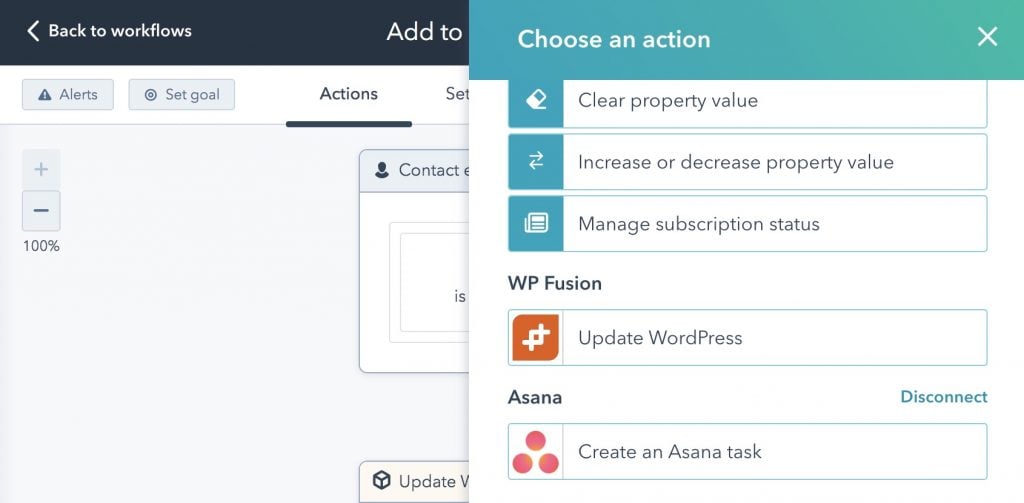
Remote Users Sync: A recurring pain point with our customers has been keeping user information in sync across multiple sites, for example having a main website for the checkout and a subdomain for courses or membership content.
In theory WP Fusion can sync user data between sites using webhooks, but it can be slow, and messy. Often passwords get out of sync, or unexpectedly reset.
Even when working properly, your customers have to wait a few minutes after checking out before they receive the welcome email with their login credentials to the course site.
We’d started and abandoned a couple of attempts at creating an addon plugin that would facilitate multiple sites communicating with eachother directly, but it’s not a trivial problem to solve.
Then, in March of 2020, we spotted a new plugin on the wordpress.org repo: WP Remote Users Sync.
This plugin ticked all the boxes, it allows user data to sync directly and securely between multiple connected sites, and as a bonus it allows for login session sharing. So a customer can check out on Site A and immediately access their content on Site B, without having to log in again.
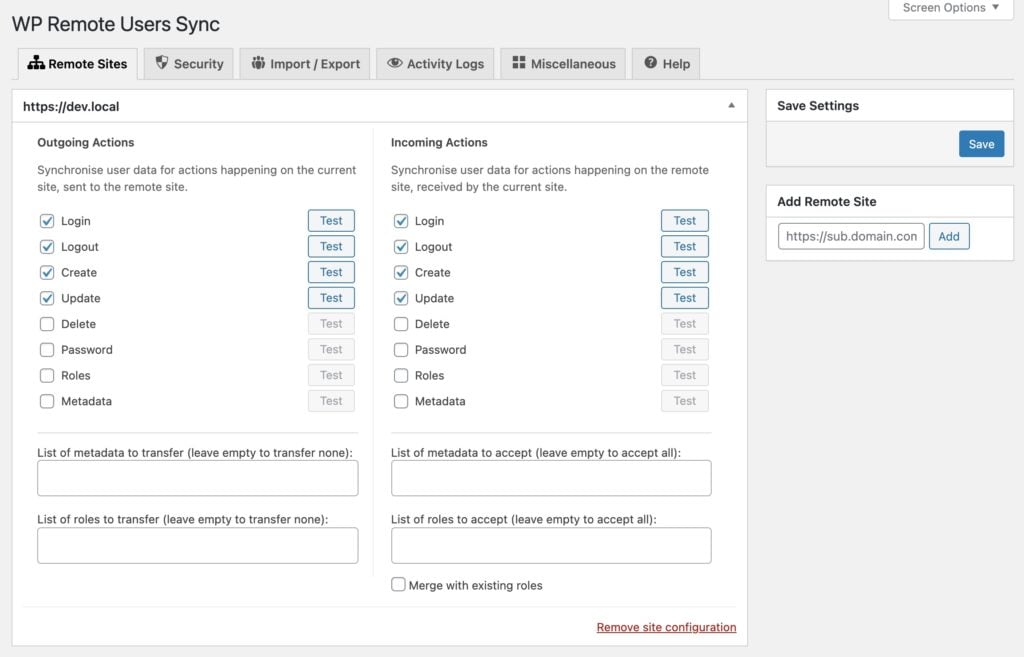
The developer was receptive to a couple of new hooks we needed, and now when WPRUS is active it will automatically sync any CRM tag changes between your connected sites automatically.
WP Remote Users Sync is now our recommended solution for synchronizing user data and login sessions between multiple sites, and it’s greatly simplified our onboarding and support efforts for customers running WP Fusion on multiple sites.
#Usage Insights
Charts time!
A note on methodology: Up until this year, we’d done our usage tracking based on the customer. So if Jane submits a ticket and she’s using Ontraport, then Jane would show up under the Ontraport column in the CRM usage graph (for example from 2019).
That wasn’t entirely accurate since many of our customers work across multiples sites connected to different CRMs. So this year we’ve updated our usage tracking system to track the selected CRM and active integrations per-website, not per customer.
#CRM Popularity
Similar to last year we see ActiveCampaign in first place with 29% of installs, and Infusionsoft’s share continuing to shrink, from 21% in 2019 to 12% in 2020.
Remarkably, Groundhogg has gone from 1% of our user base in 2019 to 8% in 2020, with over 800 sites now using WP Fusion connected to Groundhogg.
That’s a big jump. But I don’t think Infusionsoft needs to worry just yet. Groundhogg is very popular with the WaaS community, and so we’re seeing quite a lot of WaaS sites pre-installed with both Groundhogg and WP Fusion. That’s a large part of the high installation count for Groundhogg. For example one customer has WP Fusion connected to Groundhogg on 324 different domains.
Past that the order remains virtually unchanged in 2019, with Ontraport, Drip, HubSpot, MailChimp, and Zoho occupying the next positions. HubSpot did see significant gains in 2020 (3% to 6%,) as well as Mautic (2% to 5%).
On the other hand AgileCRM has declined in popularity, going from 2% of installs to less than 1%.
#Most popular plugin integrations
We can also see which plugin integrations were the most popular with WP Fusion users. See here for last year’s chart.
Note that we only track which integration modules are loaded within WP Fusion, not the actual plugins that a customer has active on their site.
This year there there are too many integrations to make one clear chart, but I didn’t want to leave out half the data either, so I’ve broken it into two. First we can see the 50 most popular plugin integrations, based on the percentage of WP Fusion-powered sites they’re active on.
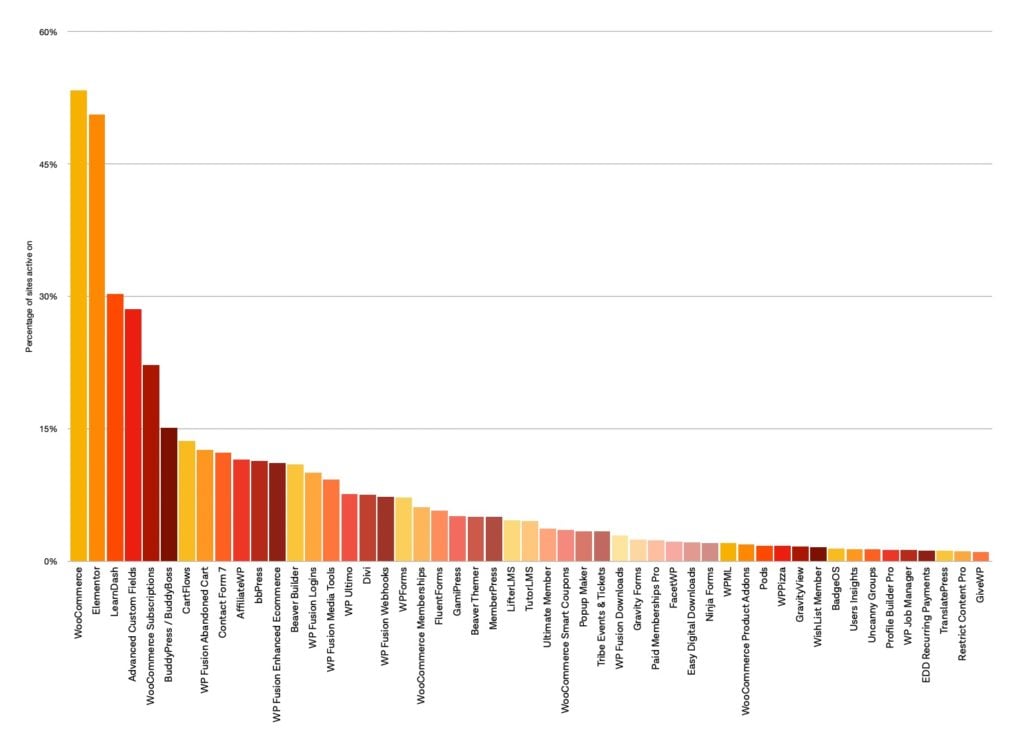
The top 50 list goes from WooCommerce on 53% of all sites, down to GiveWP running on just 1% of sites. Though out of a sample size of ~16,000, one percent is still a decent number of installs.
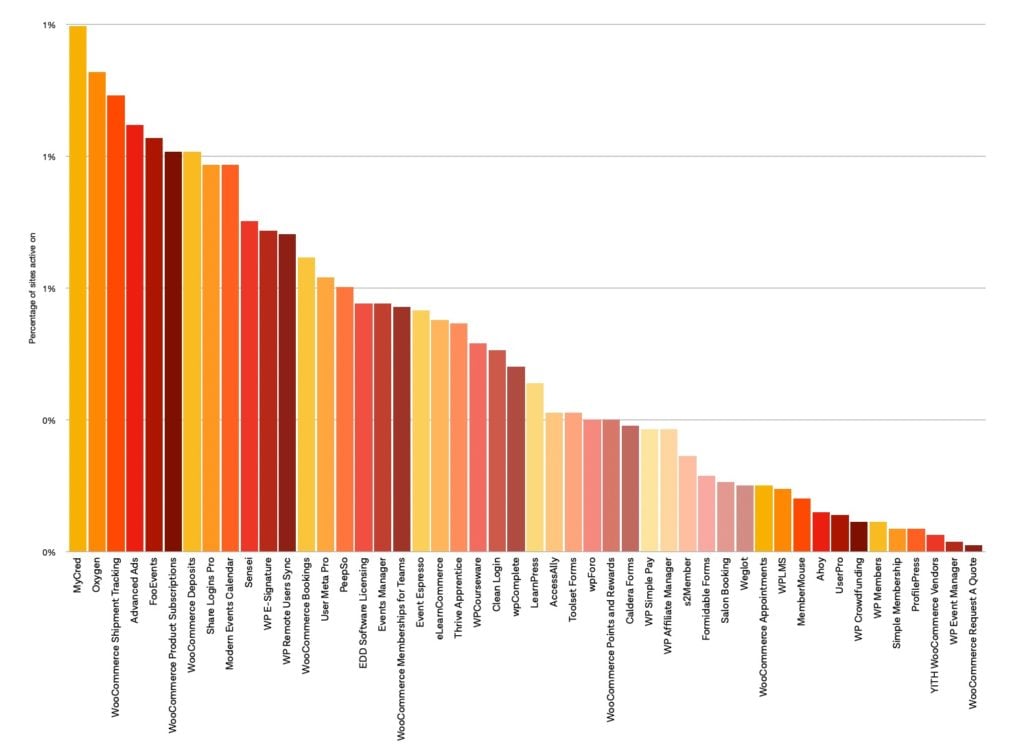
Next we have the bottom 48 plugin integrations (which conveniently also represents the < 1% group). We do support all of these, but of course the features are always going to be more limited when only a handful of customers are using a specific integration.
Like last year, we can also look at some plugins groups to see what the breakdown is in verticals like Membership, Ecommerce, Events, and Form Builders.
#Plugin Popularity – Membership
Since membership plugins are generally exclusive (you wouldn’t run MemberPress and Restrict Content Pro at the same time), we can visualize them in a pie.
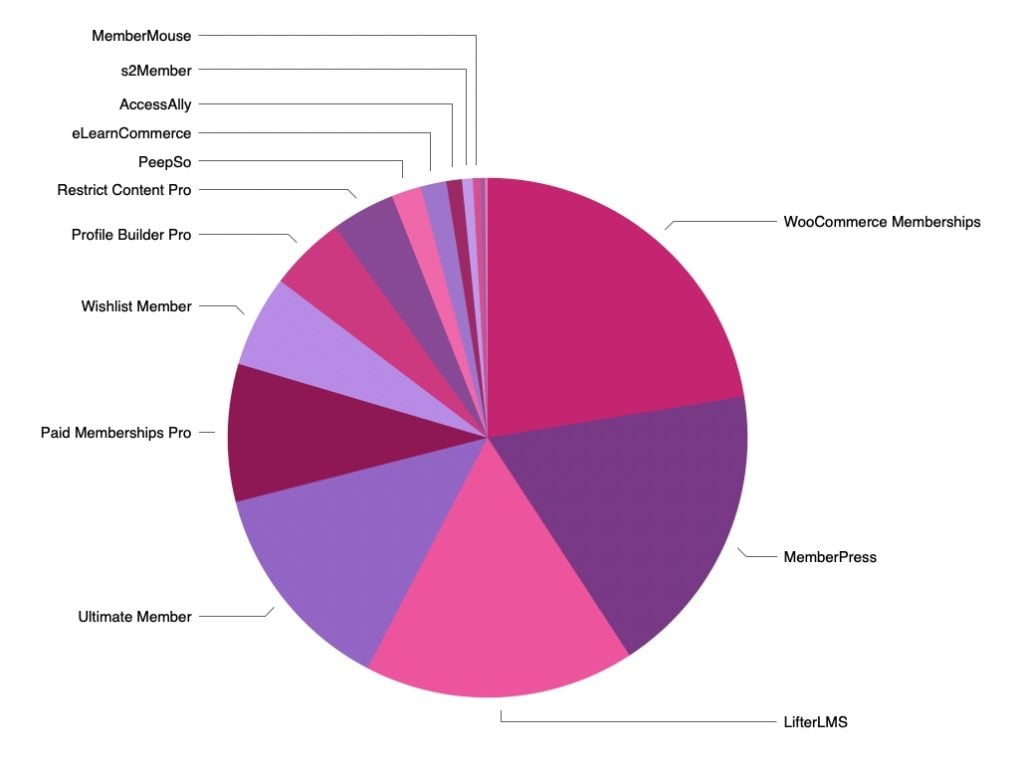
I left BuddyPress / BuddyBoss out this year (it was included last year), just because it’s usually used as a social layer in conjunction with another membership plugin (that manages membership levels and payments). As such it doesn’t qualify as a “membership” plugin like the others listed.
If BuddyPress were included it would occupy about 1/3rd of the pie (with 2,400 sites using BuddyPress + WP Fusion).
Correction Jan 27th: It was pointed out to me (correctly) that PeepSo also doesn’t qualify as a “membership” system under that logic since it’s also just a social layer, and usually requires Paid Memberships Pro or another membership plugin for payments. It’s such a small segment of the pie that I’d overlooked it 🙈.
#Plugin Popularity – LMS
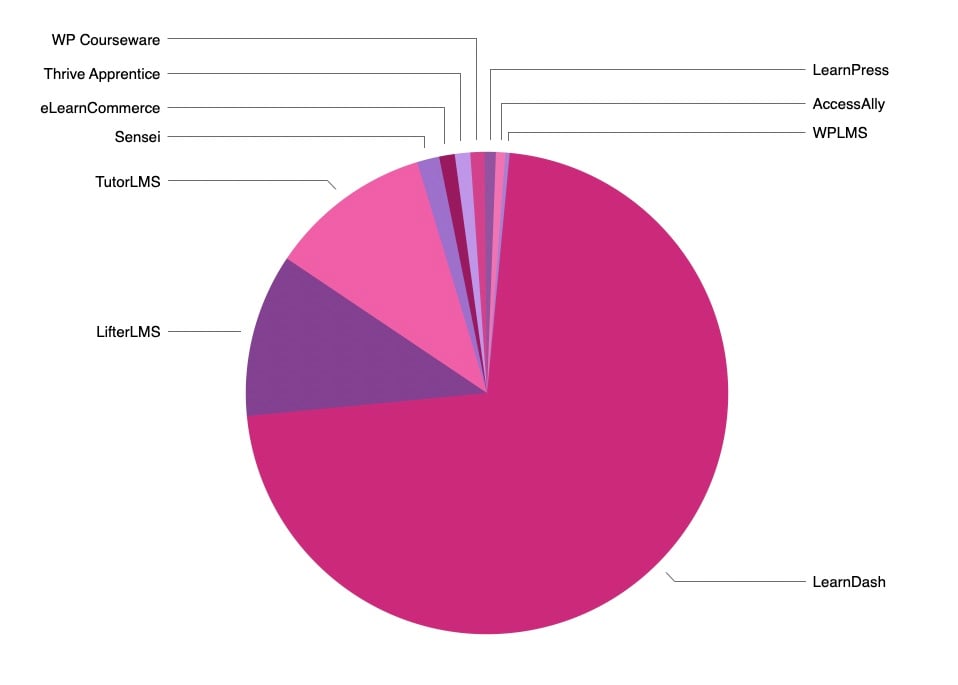
The LMS category is largely the same shape as last year, with LearnDash as the LMS plugin of choice for about 70% of our customers.
The biggest change was TutorLMS, going from 1% to 11%, at the expense of Sensei, eLearnCommerce, and LifterLMS.
#Plugin Popularity – Forms
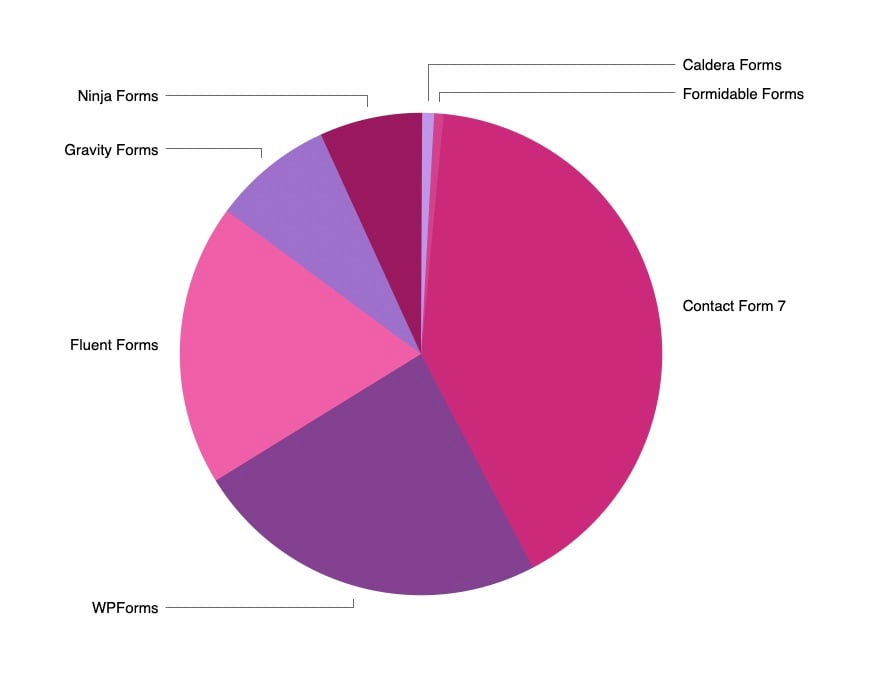
Like I mentioned last year, Contact Form 7 counts for a lot of installs because it comes pre-installed with so many themes. No surprises there.
This year we’ve seen Gravity Forms‘ share decline quite a bit (25% to 8%), while Fluent Forms has come out of nowhere to take almost 20% of the pie.
I’ve gotta hand it to the WP Manage Ninja team, they know how to launch and promote a plugin 👏
I almost wonder if Gravity Forms got a bit complacent as the “leading” form plugin for so many years. It’s what I personally use on all projects because I’m familiar with it, and the ecosystem of addons is unmatched (like GravityView).
But Gravity Forms hasn’t changed a lot in the last few years, and as a premium-only plugin I can see how freemium options like WPForms and Fluent Forms present an attractive alternative.
We’re expecting the release of Gravity Forms v2.5 very soon, and I’m interested to see if all the modern new features in that update help Gravity Forms regain some of its previous market share.
Correction, Jan 25th: Due the the way the Gravity Forms and Formidable Forms integrations modules are loaded, an update to WP Fusion around June of 2020 caused those integrations to no longer be tracked correctly when active.
That means the chart above is not an accurate representation of the of form builder plugins used with WP Fusion.
#Plugin Popularity – Events
This year I’ve added a new category for events, since we support quite a few event and booking plugins now.
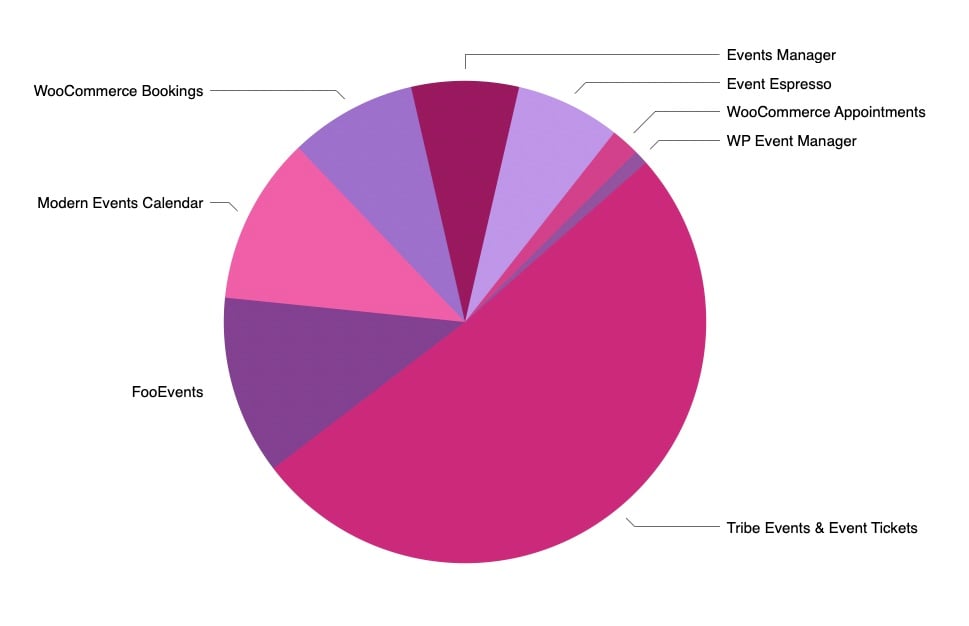
The Events Calendar + Event Tickets Plus by Modern Tribe is being used for events about 50% of the time, with the other half of the pie pretty evenly distributed between our other supported event plugins.
#Revenue
2020 was our best year for revenue, again with about 85% growth over the previous year.
- In 2018 our revenue was $160,780
- In 2019 it was $303,242
- And in 2020 we reached $557,972, with a total of 1,231 sales
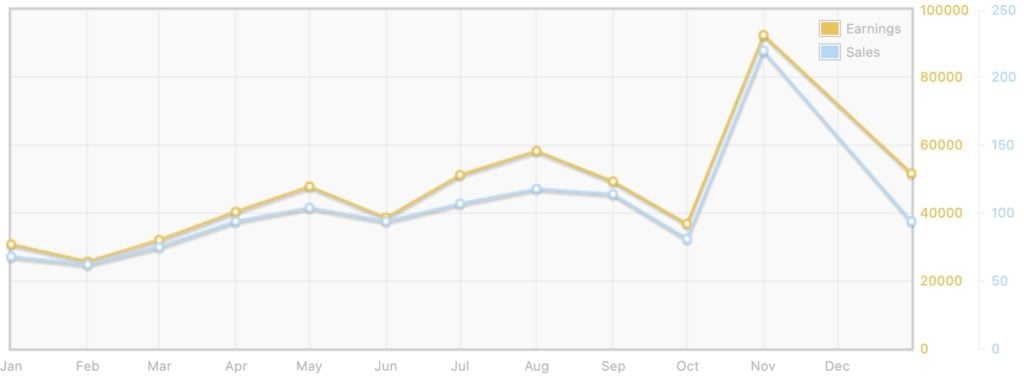
Summaries for WP Fusion in 2020:
- Total revenue: $557,972
- Revenue from license renewals: $194,464
- Revenue from license upgrades: $21,459
- Average customer lifetime value: $1,161
- Commissions paid to affiliates: $15,242
Same as in previous years, the best months were in late summer, and November (due to the Black Friday / Cyber Monday promotion).
#Affects of COVID on revenue
This year was a weird one for business. Online businesses especially. When lockdowns started happening in March it was really hard to predict how things were going to go.
Despite having a really strong year, I would say that COVID worked out to about a net zero effect for WP Fusion. No gain, no loss.
Anecdotally I know we worked with many customers who were negatively affected, and we were able to help them out by pausing subscriptions and through various discounts. I also know of some customers who went out of business or had to pivot to an entirely different model, and no longer needed our products.
Then on the other hand I spoke with a lot of folks who were setting up online businesses for the first time: restaurants, fitness studios, conferences, schools, etc. In many cases they needed to integrate their new WordPress platform with their marketing automation tool, and we were able to help them get up and running.
I am notoriously bad about second-guessing decisions, especially when it comes to any changes in our pricing or signup flow. A slow month used to keep me up at night, reviewing every change we might have made in the 30 days prior that could have depressed sales.
So for the last couple of years I’ve been fine-tuning a revenue projection model that has largely quieted those anxieties.
It basically forecasts an average monthly revenue for the year, and then adjusts the projection for each month based on that month’s historical deviation from the monthly average.
For example we always have our slowest month in February (0.51x the avg) and best month in November (1.93x the avg). It’s generally pretty accurate.
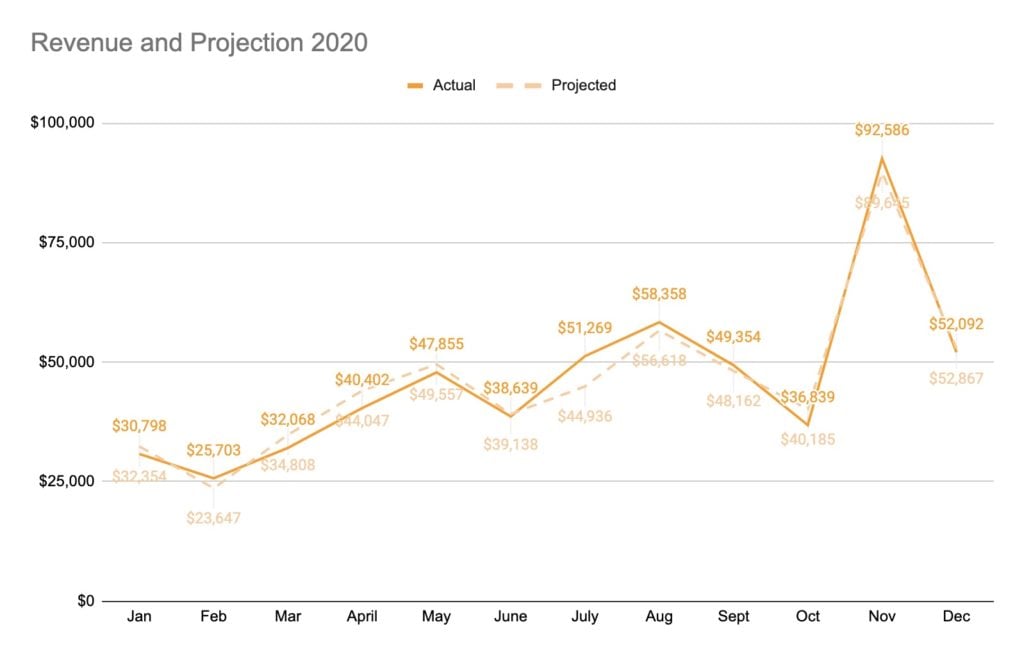
If we look at that projection vs. actual revenue chart for 2020, I think the COVID effect is visible in the spring when the first lockdowns happened. Sales were about 8% below projection for three months or so.
Then I feel like as folks settled into the “new normal” of working remotely, we started to get really busy again around July and August, with revenue about 10% above projection.
It could of course be entirely coincidental, but I felt like those fluctuations in sales volume also coincided with what I was observing in conversations with customers— a shift from, “These are uncertain times, we need to trim the budget” to, “Our new online academy is almost complete and we’re ready to implement a marketing strategy”.
Until some economists get together and write the book on COVID, we can at least have fun looking at charts and making up correlations 🙂
#Lifetime licenses
In February of 2020 we launched a lifetime license for WP Fusion.
There were a few factors that went into this:
- Anyone who’s spoken to me knows I am incredibly skeptical about any kind of lifetime pricing model. When a deal launches on AppSumo at 90% off (with 70% going to AppSumo), I see it as an express ticket to going out of business 🗑🔥.
- However, there are some people who strongly prefer to purchase software with lifetime updates, no matter the cost. Prior to 2020 we’d turned down offers to sell a lifetime WP Fusion license for more than 10x the normal annual price 🤯.
- As a person who has built many sites for clients, I can definitely see the appeal in quoting a project that includes a lifetime license purchase upfront, and then the client isn’t on the hook for annual renewals, the billing information doesn’t need to be transferred when the project is handed off, etc.
So, what we wanted to do was launch a lifetime price point for those folks who would only buy lifetime, while not making it a “deal”— the annual license should be a more attractive price point.
What we settled on was a “lifetime updates” license which included three years of support. The license was priced at 3x the annual license price. So essentially you’re paying in advance for three years of support, and you get lifetime updates thrown in as a perk.
That’s worked out well. The lifetime licenses are selling consistently, but not like hotcakes (🔥🍰.) And I don’t feel like it’s taking sales away from our annual licenses.
Charts? Sure, we got charts:
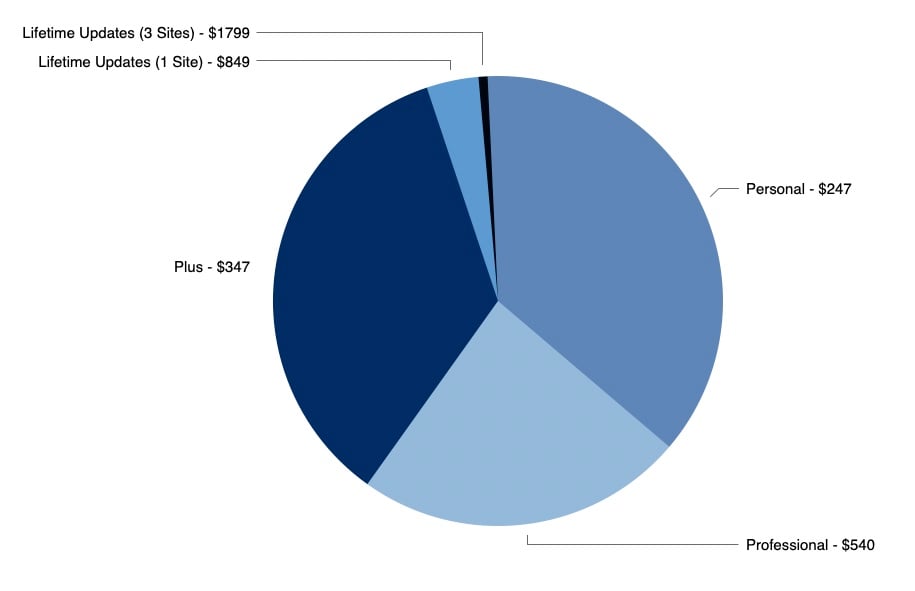
In terms of the number of licenses sold, the lifetime licenses represented 5% of new licenses sold.
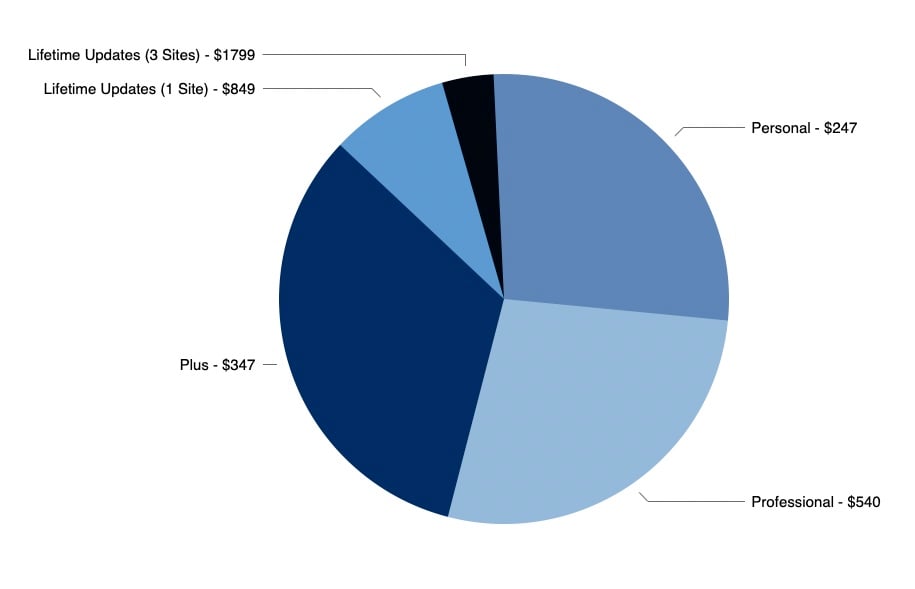
And in terms of earnings, lifetime licenses represented 13% of revenue from new sales for 2020 ($47,650).
#Renewal rates and churn
Renewal rates stayed basically the same as 2019. For more info on my methodology for calculating those, see last year’s post.
For first year renewals, we had 654 new customers in 2019, and 410 of those renewed their license in 2020, giving us a 62.69% license renewal rate.
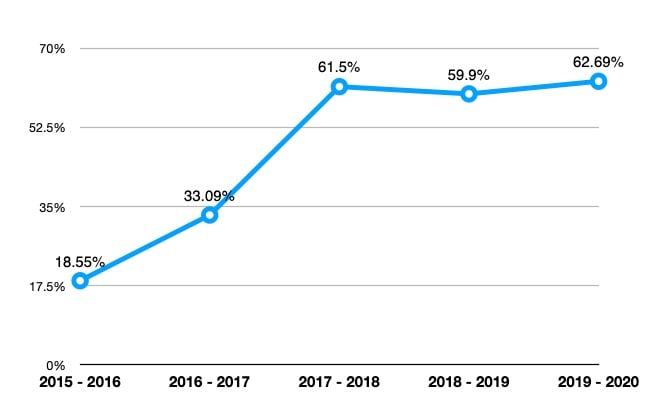
As I mentioned in 2018, we activated EDD Recurring Payments in January of 2017 and opted all new customers in to automatic renewals by default. That’s the initial upward trend you see in the graph. The first year renewal rate settled at around 60% in 2018, and it’s stayed there since.
This year we can also take a look at customer retention by cohort.
The methodology here is similar, for example to get the retention rate for 2017 we’ll just check every customer who purchased in that year, and see how many of them still had an active license at the end of 2020.
(Shoutout to our new VlutrHF server for calculating all of this in one single 6.44 second query 🍻)
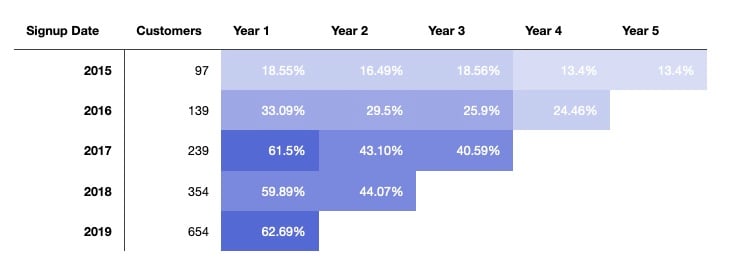
Pretty cool. Out of the 97 customers who signed up in 2015 (our first year), 13 of them still have an active license. Thanks guys! 🙏
#Black Friday – Cyber Monday
Like last year, we ran a Black Friday / Cyber Monday sale with 30% off all new licenses (excluding lifetime).
We only ever offer one discount per year so this tends to attract a fair bit of attention.
Last year went well so we stuck to the same playbook, running a “traditional” Friday to Monday sale. No giveaways, no Pre-Sale Sale, no fancy tricks.
Again the BFCM weekend was our strongest revenue window for 2020, with 142 new customers, and a total sales volume of $55,248 over the four day period.
That actually represents a 8% decrease in the number of new customers from BFCM 2019, even though revenue was up 31% (largely due to renewals from previous years).
We did not do any outreach this year to blogs or “roundup” lists, aside from our affiliate network. And honestly I wasn’t looking to significantly “out-do” the 2019 figures.
WP Fusion is a premium solution within a small niche, and we don’t really have any direct competitors in terms of functionality. An annual 30% off sale is a good opportunity to convert those “I’m not sure if I need this, but I’d like to try it out” customers, but we’re not trying to push the offer has hard as we might be if we were fighting for market share with a direct competitor.
#Misc. Revenue – Dunning
We set up ChurnBuster in July, which does automatic card retries and reminders for skipped subscription payments with Stripe.
At $49 / month it’s definitely paid for itself. Super easy to set up, I have only good things to say about it 👍
#Support
Across email support (via HelpScout) and chat support (via Chatra) we had 5,440 support conversations this year, with 10,564 messages received.
That’s about a 50% increase increase in support volume over 2019.
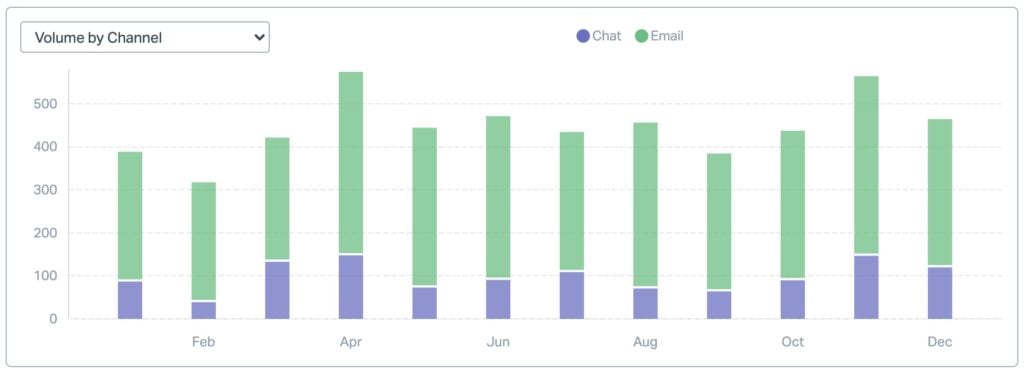
#Support team
To handle the increasing support load, some friends suggested I get in touch with Arron at LevelUp.support (WordPress plugin support specialists). We started talking around December of 2019, and by June of 2020 we were ready to start Ace Miranda from LevelUp on WP Fusion support.
WP Fusion is a particularly difficult plugin to provide support for because it’s an integration tool. Not only do you need to work through the usual troubleshooting steps in WordPress (caching, conflicts, etc.)— but you also need to be able to run tests in about 60 different plugins, and then on top of that know your way around Salesforce, Infusionsoft, Zoho, and other complex business CRMs.
There’s basically no way we could have written a manual that a support rep could follow that would cover any meaningful subset of the kinds of inquiries we receive, so it was always going to be a bit of a trial by fire situation— I’m delighted to report that Ace rose to the challenge, and has probably been the best thing to happen to this business thus far.
Averaged over the last three months, Ace has handled 59.5% of our incoming support inquiries. So even though support volume is up 50% over 2019, the time I’m having to spend on it has actually gone down. As we like to say, “Ace is on the case!”🕵️♂️
Thanks Ace! ♥️
#Response times
We can look at a few more stats out of HelpScout.
The average response time to any support message was 2hrs and 18 minutes during our business hours (GMT+1), and the average time to send the first reply to a new ticket was 1hr and 56 mins.
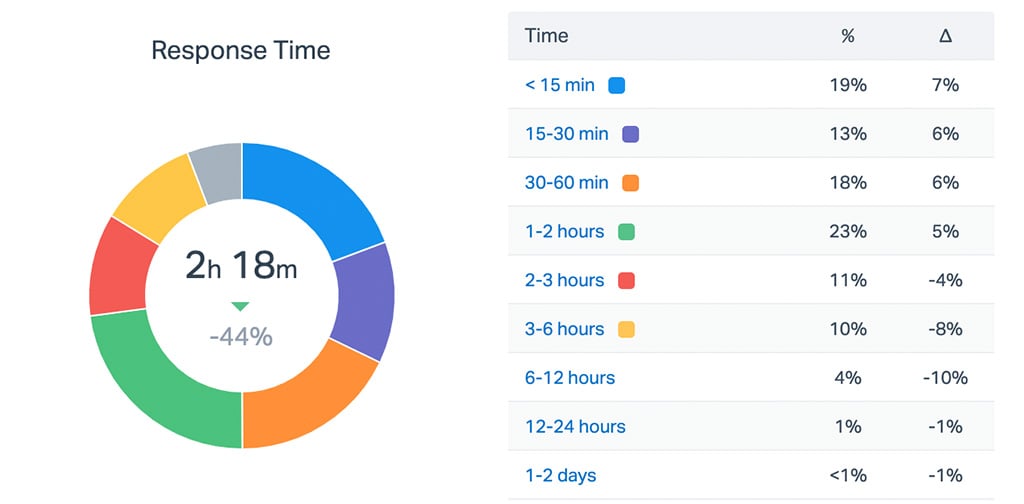
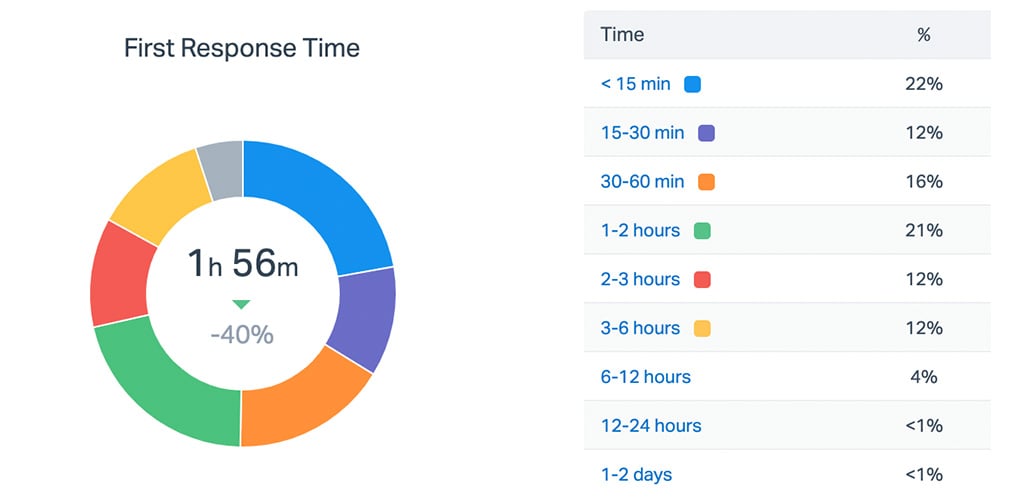
Both of these metrics are significantly faster than last year, though as I mentioned then, the 2019 stats were kind of messed up when I relocated from the US to Germany but had left the business hours in HelpScout set to EST for a few months.
The stats were more accurate in 2018 when we had an average 3hr 50 min response time, and 1hr 38min first response time. Looking at 2018, this year’s metrics represent an improvement in the overall response time, but more delay in the first response time.
HelpScout also tracks resolution status of tickets, so we can take a look at both the number of replies to resolve an issue, as well as the overall resolution time:
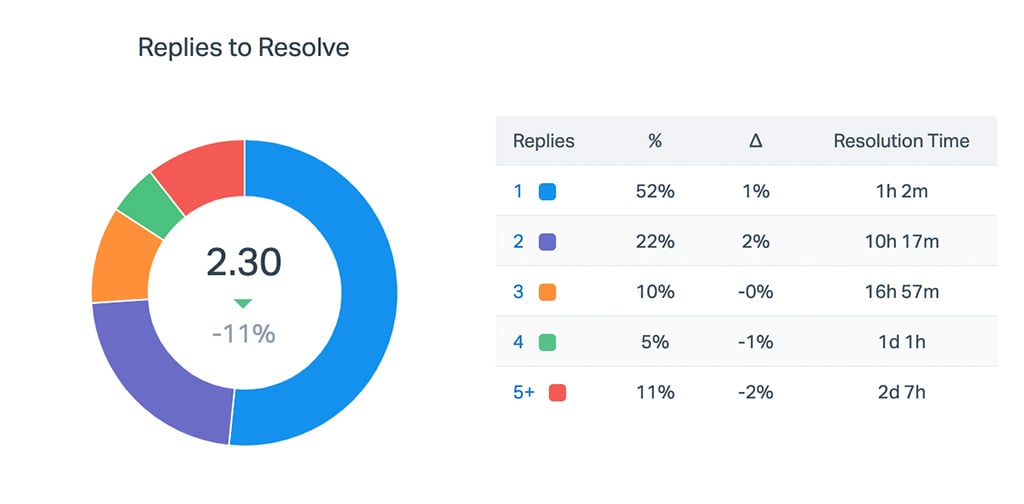
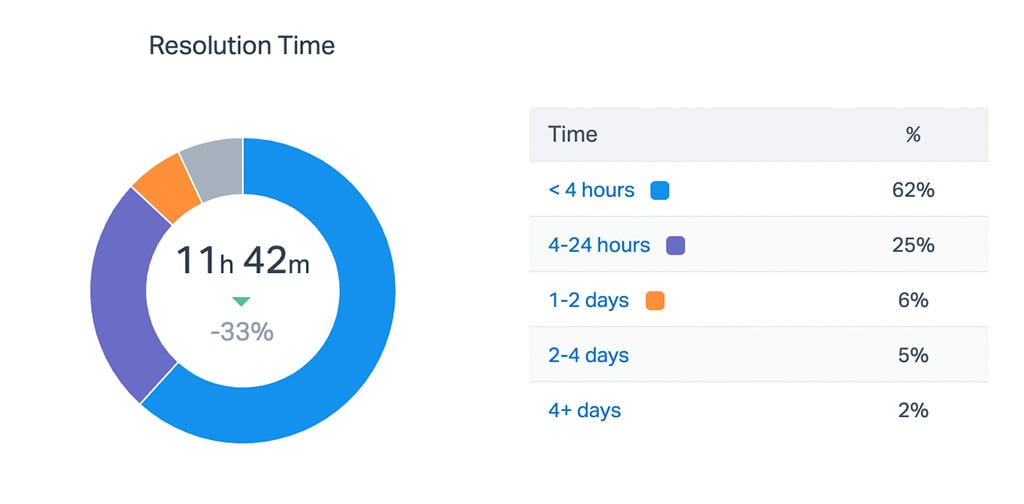
And as you can see the replies to resolve and overall resolution time both showed significant improvements over 2019, with 62% of tickets getting a final resolution in less than four hours.
#Reducing new customer friction
A big push for 2020 was shifting our focus from responding to support requests, to anticipating potential issues and preventing them from requiring a support touch in the first place. Especially for new customers.
Our documentation is pretty extensive, but it’s easy to fall into a habit of continually updating the docs with suggestions and solutions, and then begrudging the customer when they haven’t read the docs (especially as the docs grow longer and longer).
That effort in 2020 involved both some dissuasion, and nudging in the right direction.
By dissuasion I mean that we’ve updated our marketing and documentation to try and discourage any prospective customers from buying WP Fusion for “off-brand” purposes.
For example it is possible to use WP Fusion to sync users between two different websites. We used to acquire a lot of customers looking for this solution, who had no understanding of CRMs or marketing automation. The whole process of setting up automation rules and webhooks (especially with security plugins and firewalls) to keep user accounts in sync was as frustrating for us as it was them. Now our docs advise against using WP Fusion for that purpose.
Likewise we now discourage using ThriveCart with WP Fusion, except for expert users.
And we’ve added compatibility ratings to our CRM integrations reference to make it clear which integrations are only suitable for advanced users, or known to cause problems.
Within the plugin, new prompts appear whenever anything is enabled that has the potential to mess up your data, or anything that should be enabled only after fully understanding the consequences.
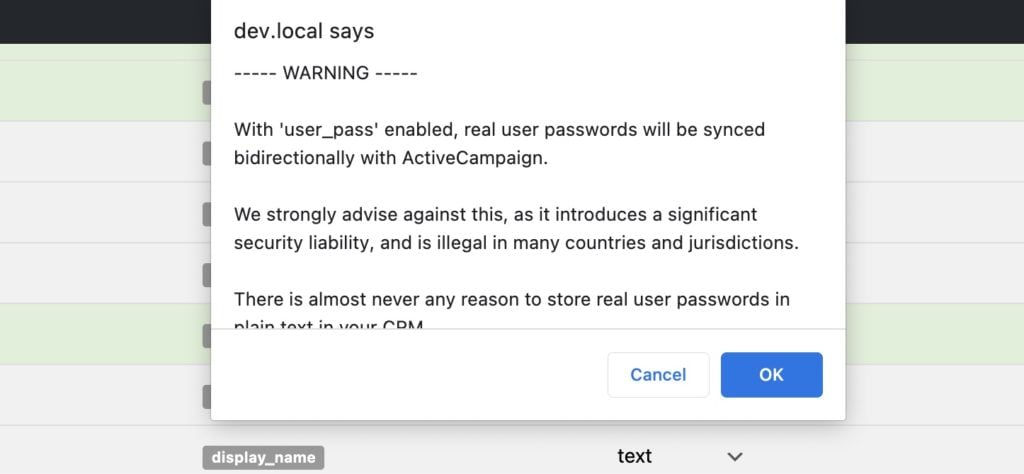
In terms of nudging / operant conditioning, as much as possible we looked at every support conversation through the lens of, “what could we have done to prevent this support touch in the first place?”
What that looks like in the WP Fusion plugin in 2020 is dozens of new tooltips, log messages, warning banners, etc., that try to discourage configurations that are known to have caused problems in the past, and give suggestions when errors are encountered.
Some examples:
#New customer support request rates
That’s all a bit technical and boring, but, the question is whether it would be possible to see a result of those efforts in the percentage of new customers requesting support.
To run that calculation, I took all licenses that were purchased in each calendar year, and cross referenced them with support requests (which require a license key) made in the following period (30 days and 365 days).
In 2018, 36% of customers requested supported within the first 30 days of purchasing, and another 10% within the rest of the year.
In 2020 that number has gone down to just 21% of customers requesting technical support in the first 30 days, (and another 8% requesting technical support within the rest of the year).
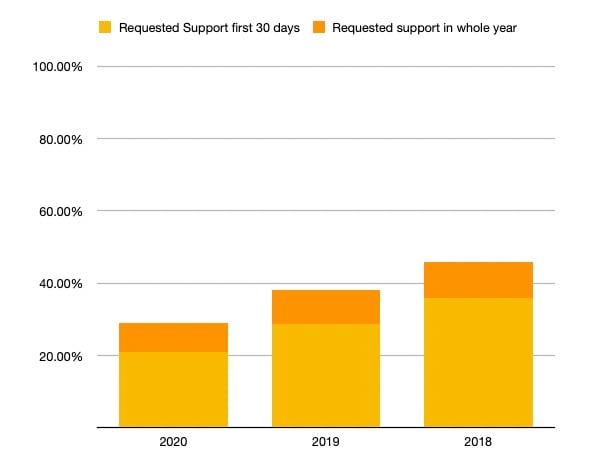
That looks like a clear win— fewer customers are needing technical assistance to get started with the plugin.
Let’s see if there’s a correlation to be found in the percent of customers requesting refunds:
#Refund request rates
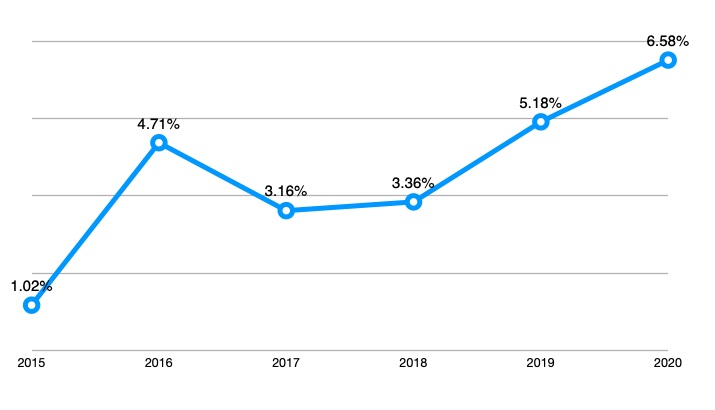
Huh. The refund rates have actually gone up, from 3.36% to 6.58% 🤔
My guess would be that’s related to the loosening of our refund policy around the end of 2018. Previously the refund policy said:
Note: Refunds will not be given if you simply decide not to use the purchased products. We stand behind our work and will assist you in solving any problem you have, but we also expect you to adequately understand what you are purchasing and why.
That was updated in 2018 to be a 30 day unconditional refund policy, so it’s possible (I’d say likely) that more people felt comfortable trying out the software knowing they could get a refund if things didn’t work out.
I can’t think of a way to validate that other than to run the same report next year and see if the refund request percentage has continued to increase. If anyone else has any insights on refund request rates in relation to refund policies I’d love to hear them.
#Marketing
Marketing was pretty quiet this year. We didn’t run any paid ads, and stopped content marketing on the blog around the beginning of the year.
I mentioned last year running an experiment to drive more search traffic by creating landing pages that pair the plugins WP Fusion supports with our supported CRMs (for example “Connect WPForms to HubSpot“). Similar to how Zapier seems to show up for every “Connect X to Y” search result.
We now have 4,168 of those dynamically generated landing pages.
Those pages brought in 52,000 page views (10% of our total traffic), and 11,563 users clicked through to the rest of the site, generating $24,018 in revenue.
Not bad considering it only took a few minutes to set up and didn’t cost anything.
#Other stats
Some other tidbits that are headed in a nice direction:
WP Fusion Lite: The free version of WP Fusion hit 2,000 active installs on July 29th, 2020. Woohoo!
WP Fusion Lite also brought home 3,127 web sessions, and $21,537 in attributable sales (I suspect the actual numbers are higher, since not everyone would click the UTM link).
Facebook Community: Our Facebook group, Marketing Automation for WordPress with WP Fusion, almost doubled in size again in 2020 and now has 1,490 members.
It’s a really wonderful little corner of the internet, and we have awesome mix of members from all levels of experience and backgrounds.
#Web stats
Web stats were up in terms of visitors, though bounce rates went up and the avg. time spent on the site went down.
That could be a result of pulling in more Google search result traffic (see above) from the generated landing pages, and then folks bouncing away when they realized WP Fusion wasn’t what they were looking for.
We’ll keep an eye on that, and if the change is indeed related to the new landing pages, then we could expect the bounce rate / pages per session variables to stay the same next year.
#Fatal Error Notify
We develop one other plugin under the Very Good Plugins banner, Fatal Error Notify.
It’s primarily aimed at developers (and it’s more a labor of love than a serious commercial venture), but it also got some attention in 2020 with six plugin updates.
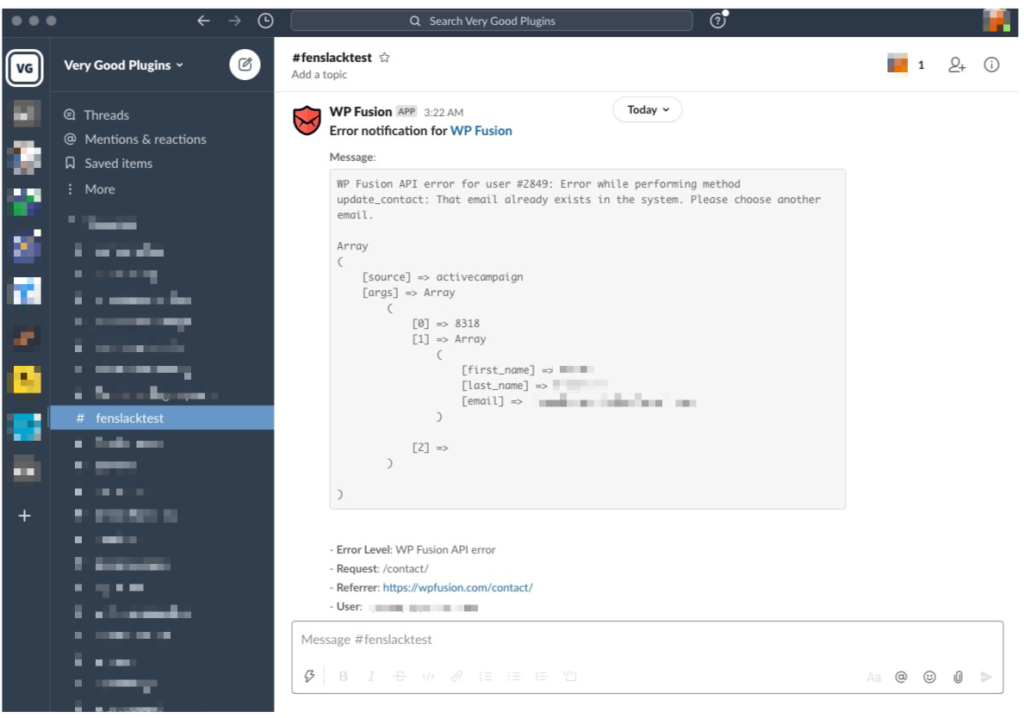
Fatal Error Notify Pro brought in a respectable $2,816 in revenue 2020, and the free version grew to 2,000+ active installs on the wordpress.org repo.
#Summary and looking forward
Writing this post is always a lot of work, especially with all the data wrangling (I’ve clocked 26 hours up to this point). But it goes by really quickly until I get to the summary and then I hit a bit of a wall.
It would be typical to list some wins from the prior year and then provide a few bullet points of new initiatives, maybe a big new feature or extension. But there isn’t actually anything very interesting on the roadmap 👀.
I enjoyed reading Sahil Lavingia recent post, No Meetings, No Deadlines, No Full-Time Employees, about the state of Gumroad in 2020, and I think that sums up my philosophy pretty well.
We have a lot of growth opportunities, and while it’s tempting to try and scale the team and launch new products— it’s not what I’m good at, or enjoy. I’m a creator, not a manager.
So I think in 2021 we’ll just keep doing what’s worked so far— building the features that people need, refining the systems we already have, and generally doing whatever we can to facilitate our customers’ success.
And if we do that with a team of two instead of twenty, that’s okay— that’s the pace we’re comfortable at.
Thanks for reading, and thanks especially to our customers— none of this would be possible without you. Best of luck to all, in 2021 and beyond! 🎉
— Jack Arturo
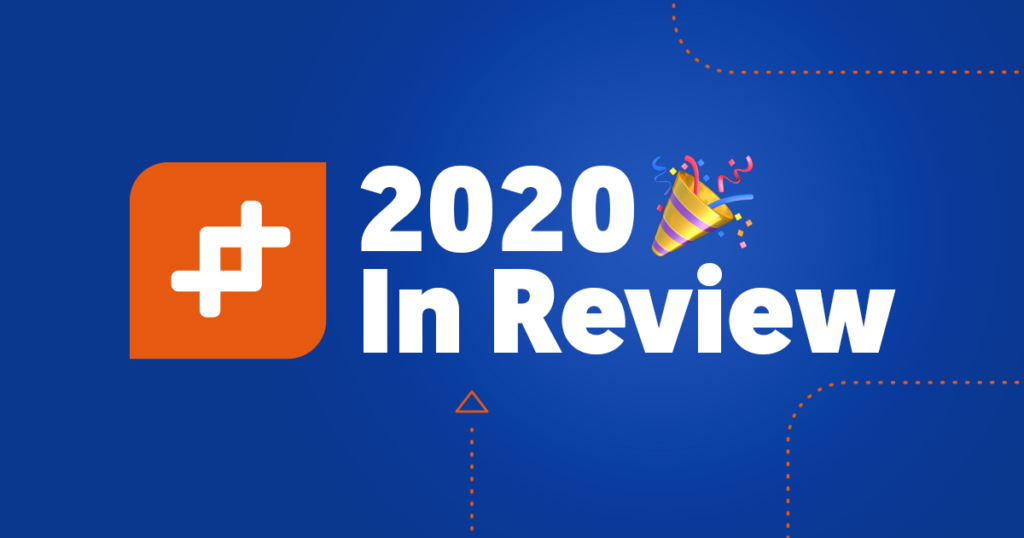
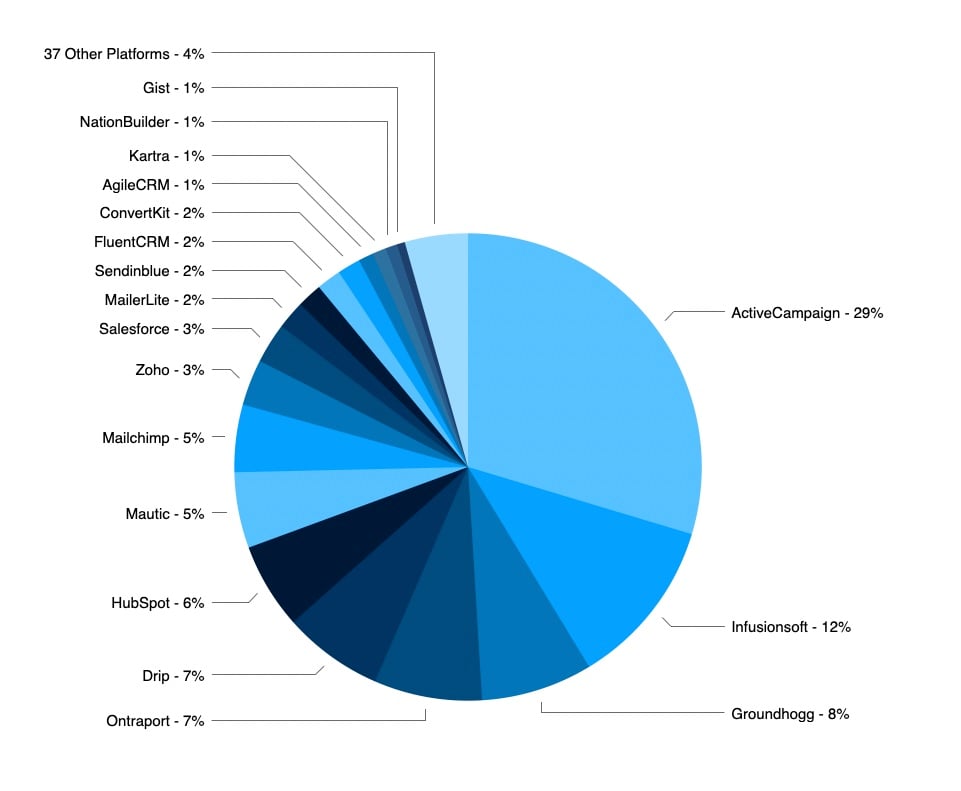
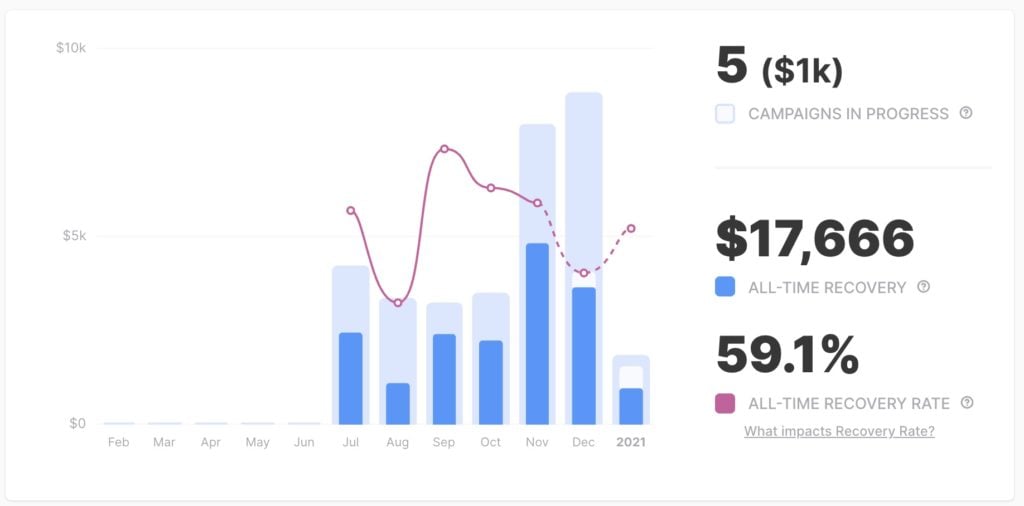
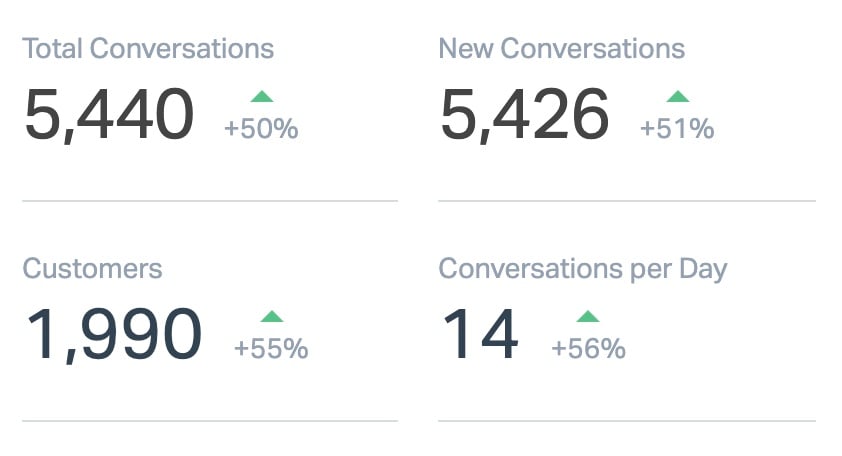


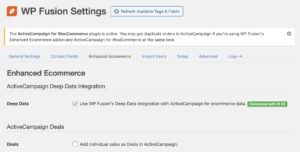

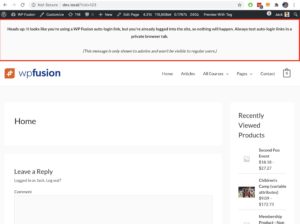
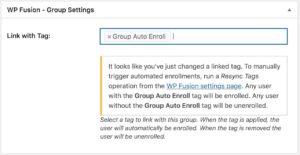
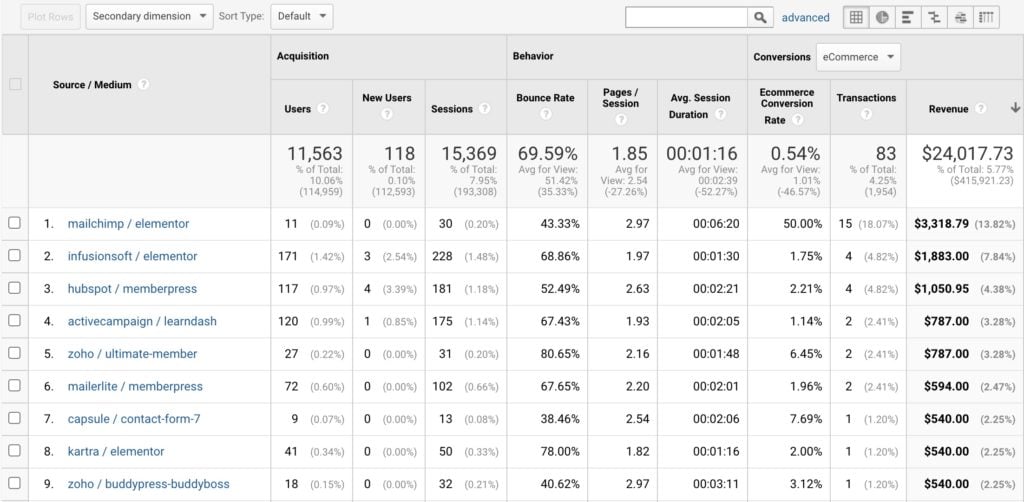


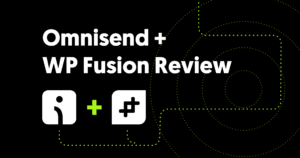

10 thoughts on “2020 In Review”
Awesome work once again Jack! Such great insights, I look forward to this every year. Really makes me wish I had jumped on the FluentCRM bandwagon early though!
Really excellent post, Jack. Thanks for sharing so much about your numbers, process, etc. This is right up there with Pippin’s yearly review posts, and that’s saying something .
I particularly loved:
– the automated pages you created that brought in 10% of your web traffic
– “Ace is on the case!”
– the notices & tooltips you added throughout the UI
– telling people NOT to use your plugin for certain things
– your lifetime license approach (updates forever, support for 3 years)
The main reason I’ve not marketed a lifetime license is for fear of providing support forever, especially for a needy customer. Your solution handles that.
I know EDD doesn’t provide the greatest reports (hopefully 3DD will change that soon). Do you mind sharing how you pulled together so many of these numbers, charts, reports? Did you put numbers in a spreadsheet & use Google Charts? Or are you using other reporting tools?
I allow people to pay via Stripe & PayPal so I can’t easily just import my Stripe data into a reporting tool to get accurate reports.
Thanks Dave!
Pippin inspired me for sure, trying to pay it forward if I can 🙂
No, the EDD reports aren’t great, haha. A lot of stats come from PHP functions I’ve written from previous years and then re-used. For example the churn calculation at https://pastebin.com/AEsN1asQ
Then some stuff I export from our DB, some other stuff comes from EDD exports, and then it all goes into one big Google Sheet.
When the results are calculated I then copy it back down into Numbers on OSX because I like the chart styles better 😉
If I get some time this year I may work on some EDD addons for reporting that could automate some of it. Been playing with making a 7 Day Rolling Sales Average chart EDD at the moment, but it’s hard to find the spare time.
Cheers, thanks for reading!
Wow. OK, you definitely put a lot of custom work into this, which makes it an even cooler year-in-review post now.
Thanks for sharing that PHP code.
Cheers!
This is awesome. Thanks for sharing your business and how you manage the lumpy revenue. These are helpful insights. I can only aspire to be as thorough as you in my own business!
Hi Jack,
Awsome product, incredible update. wpFusion keeps getting better. It’s amazing what you do with this product, and it’s amazing how well it works. Thank you for all your efforts, including your support.
Cheers my friend 🙂
Dan
Thanks Dan!
Great post and great work you do 🙂
WP Fusion helps me a lot in business.
Keep it up…
What is your target date to complete testing WP Fluent Forms with WP 5.6?
Hi Larry,
Not sure I fully understand. There’s nothing that needs testing as far as I’m aware… WP 5.6 has been out for months now, and WP Fluent Forms is already running on 50,000+ sites. You should be good to go